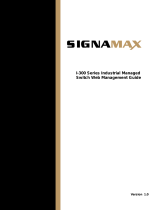14.1.3 NDP Config ...................................................................................................... 224
14.2 NTDP .......................................................................................................................... 225
14.2.1 Device Table .................................................................................................... 225
14.2.2 NTDP Summary .............................................................................................. 226
14.2.3 NTDP Config ................................................................................................... 228
14.3 Cluster ........................................................................................................................ 229
14.3.1 Cluster Summary ............................................................................................. 229
14.3.2 Cluster Config .................................................................................................. 230
14.4 Application Example for Cluster Function .................................................................. 232
Chapter 15 LLDP .......................................................................................................................... 235
15.1 Basic Config ............................................................................................................... 239
15.1.1 Global Config ................................................................................................... 239
15.1.2 Port Config ...................................................................................................... 240
15.2 Device Info ................................................................................................................. 241
15.2.1 Local Info ......................................................................................................... 241
15.2.2 Neighbor Info ................................................................................................... 242
15.3 Device Statistics ......................................................................................................... 242
15.4 LLDP-MED ................................................................................................................. 244
15.4.1 Global Config ................................................................................................... 245
15.4.2 Port Config ...................................................................................................... 246
15.4.3 Local Info ......................................................................................................... 247
15.4.4 Neighbor Info ................................................................................................... 248
Chapter 16 Maintenance .............................................................................................................. 250
16.1 System Monitor .......................................................................................................... 250
16.1.1 CPU Monitor .................................................................................................... 250
16.1.2 Memory Monitor .............................................................................................. 251
16.2 Log .............................................................................................................................. 251
16.2.1 Log Table ......................................................................................................... 252
16.2.2 Local Log ......................................................................................................... 254
16.2.3 Remote Log ..................................................................................................... 254
16.2.4 Backup Log ..................................................................................................... 255
16.3 Device Diagnostics ..................................................................................................... 256
16.3.1 Cable Test ........................................................................................................ 256
16.4 Network Diagnostics .................................................................................................. 257
16.4.1 Ping ................................................................................................................. 257
VIII





















